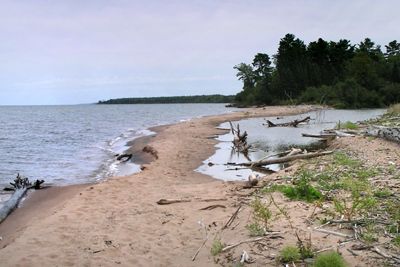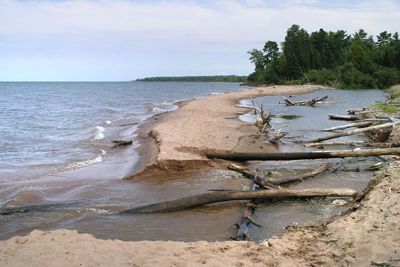
There is an almost universal impulse for humans to alter their environment. It has served us well so far, as we are the most influential species of mammal on the planet. Whether making a shelter in the branches of a tree, a bridge over a crevasse or a frivolous sand castle on the beach, the goal-oriented, engaging activity of manipulating natural objects to create a sense of order is so alluring that it is almost a compulsion.
Anyone who has spent a lazy summer day playing in a clear, rocky stream knows the irresistible urge to build a dam. Flowing water paired with readily accessible objects we can maneuver to disrupt it provide a simple diversion of no particular consequence other than to give ourselves something to do. The way the ripples caress the stones, slithering around each new obstacle, until every passage is blocked and there is no choice but to slow and form a pool, is ridiculously satisfying to young and old alike.
In September of 2003, Larry and I made the trek from central Texas up to Wisconsin to visit with my sister, Vicky, her husband, Tom, and their children, Lucas and Isabella. Vic was seven months pregnant with her third child, but that didn't slow her down one iota. In between routine chores and pastimes, we enjoyed hikes, a swim in a rather chilly lake, visiting a cave, the rides at a local carnival, a trip to see her horse and an excursion to the Minnesota Landscape Arboretum. We also drove up to Lake Superior, just east of Duluth, simply to look at a lot of water. Although it sounds inconsequential, anybody who has stood on the shore of one of the Great Lakes knows the awe and wonder of that huge expanse, appearing as vast as an ocean, but without the salt smell.
We pulled off Highway 13 onto a short side road, parked and climbed down a steep wooded embankment and, lo and behold, we were on a private beach! It was definitely too cold for a swim, so we contented ourselves with walking the driftwood littered sandy shore in both directions until it gave way to stands of pines. It was delightful, and it would have been reward enough to just sit on one of the smooth logs and gaze at the amazing vista before us. As we walked to the eastern end of the cove, however, I noticed that there was a pond that bordered within a few feet of the huge lake, and it seemed to have a slightly higher elevation. It was either a fairly long pond or a creek, because it extended far enough inland that there was a substantial bridge where the nearby highway crossed it. I wondered if I could make a little channel and let the two bodies of water connect. Using a stick, I scraped a bit into the sand on the pond side. As the water quickly flowed into my little ditch, I continued dragging the stick deeper and closer to the great lake. It was fascinating to see how eager the water was to reach those few inches lower and closer to, well, freedom. It took a bit of effort to dig deep enough through the largest hump of sand, but once I had, the water started to do the work for me.  As I watched, it slowly began to flow through my new channel and form little ridges in its bed as the shallow rivulet moved the sand. The sides of the canal started to collapse. It was so small, though, that it was like looking at a little model, created in a laboratory, of a phenomenon that could normally be seen on a grand scale. I knelt close and could see how all the sand grains on the sides were starting to wash away, then stood for a more general view while it almost imperceptibly started to widen. I quickly realized that I'd better tell the rest of the family, who were on the far side of the new rift, that they should probably start walking back to where we'd parked.
As I watched, it slowly began to flow through my new channel and form little ridges in its bed as the shallow rivulet moved the sand. The sides of the canal started to collapse. It was so small, though, that it was like looking at a little model, created in a laboratory, of a phenomenon that could normally be seen on a grand scale. I knelt close and could see how all the sand grains on the sides were starting to wash away, then stood for a more general view while it almost imperceptibly started to widen. I quickly realized that I'd better tell the rest of the family, who were on the far side of the new rift, that they should probably start walking back to where we'd parked.
There was no rush, as the little stream was well-behaved and more of a curiosity than a concern. It was quickly evident that the pond definitely was at least several inches higher than the lake, and gravity was now taking its course. All that water was destined to end up in Lake Superior. Having an assembly of four adults and two children, it was inevitable that we would see if we could assist it, and do so as quickly as possible. More sticks and more muscle, and within minutes, the stream was too broad to step across. Power is exciting, so we all wanted to see the water flow faster and wider. Everyone helped, using sticks to scrape away more sand and gouge ridges to deepen the base. We were now all on the near side and the rest of the cove was inaccessible. In fact, I suspect that an open channel was the norm and somehow conditions having to do with wind and currents had piled up the sand that created the temporary dam we encountered on our little beach stroll.
somehow conditions having to do with wind and currents had piled up the sand that created the temporary dam we encountered on our little beach stroll.
At some point, Vicky realized that she probably shouldn't work too hard at this escapade, so she entertained the dogs and kids while Larry, Tom and I continued to play. It eventually became apparent that the channel would continue to expand even without our help but at a more leisurely pace. And we were keen to see just how big it would get within the time we could spend watching. As the flow increased, sticks, then logs, started to float down. They threatened to jam our new canal, but, using more sticks and some manpower, the course was not only kept open, it kept deepening and widening.
Over a period of at least an hour, maybe more, the kids enjoyed scraping the sand on the edges, helping move large logs that had gotten stuck, and throwing rocks and sticks into the resultant torrent. So did the adults. As the entire endeavor grew to a scale that was no longer remotely miniature, Tom did some big boy maneuvers to keep logs from hindering what was now quite a satisfying surge of water. Various objects floated down from what I later learned was Fish Creek. Most were just sticks, logs and leaves, but at one point I saw a confused looking frog hop up on the shore from the lake.
People who have never experienced the actuality of flowing water often underestimate its sheer power. Some of the most impressive things I learned while involved with canoe clubs were about this very aspect. We were taught that, if capsized in a river where the water is waist deep, it is prudent to swim or float to shore, not try to walk out. I can still vividly recall a very disturbing video of a man trying to do the latter, getting his foot caught, and the current pushing him under. He drowned before any of the onlookers could rescue him.
One other proof of water power I encountered as a youth was an aluminum canoe, wrapped so tightly around a curved bridge pillar that it was almost embedded in the concrete. The boat had overturned, filled with water, and then been pressed against the column. It was still there months later because the water was like a vise.
Maybe our preoccupation with flowing water stems from a deep instinctual need to understand its limits, if only to assure our own survival. Maybe it is that we enjoy witnessing the often remarkable natural processes that shape our landscape. Maybe we just like to entertain ourselves with relatively pointless activity. Whatever the motivation, the afternoon we spent releasing the river is certainly among my most fondly remembered vacation experiences.